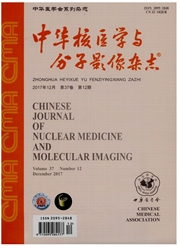

 中文摘要:
中文摘要:
目的 评价脂质体介导对^99Tc^m-表皮生长因子受体(EGFR) mRNA反义PNA体外靶细胞摄取、荷瘤裸鼠体内特异显像及生物学分布的影响.方法 利用碱基互补配对原则将带有短肽螯合功能的EGFRmRNA反义PNA与部分互补寡核苷酸杂交,再以配体交换法对反义探针进行^99Tc^m标记,然后以脂质体包裹反义探针,用HPLC法鉴定标记物的标记率.分析脂质体介导及非脂质体介导^99Tc^m-EGFR mRNA反义PNA在体外人卵巢癌SKOV3细胞中的摄取率及滞留率的差别,同时分析两者在荷SKOV3卵巢癌裸鼠模型体内生物学分布及显像情况的差异.数据分析采用两样本t检验(或t'检验)及Wilcoxon秩和检验.结果 脂质体介导及非脂质体介导^99Tc^m-EGFR mRNA反义PNA6h内标记率均在95%以上.两者在注射后1、2、4、6、12及24 h后的细胞摄取率分别为(28.90±1.12)%、(32.76±1.20)%、(38.20±3.11)%、(41.23±1.60)%、(46.63±1.55)%和(46.78±2.14)%,(3.51±0.39)%、(3.90±0.40)%、(4.69±0.18)%、(5.91±0.26)%、(5.30±0.22)%和(5.39±0.17)%,差异有统计学意义(t'=47.11~58.67,Z=2.80,均P<0.05),两者滞留率差异亦有统计学意义(t'=7.25~11.55,Z=2.80,均P<0.05).注射两探针后1h荷瘤裸鼠肿瘤部位均可显像,但脂质体介导使肿瘤显像更为清楚,肿瘤摄取高峰T/NT由3.95上升至5.02,并明显增加注药后各时间点T/NT(t=3.96,t'=12.65~ 14.69,Z=2.83~5.29,均P<0.05).分子探针主要分布在肿瘤、肾脏及肝脏组织中.肿瘤摄取量随时间逐渐增加,1h时非介导组为(1.49±0.09) %ID/g,介导后为(2.15±0.21) %ID/g;6 h时分别为(3.90±0.65) %ID/g和(5.00±0.10) %ID/g;脂质体介导后可增加注药后各个时间点的肿瘤/肌肉(t=11.24,t'=3.96~ 11.94,均P<0.05).结论 脂质体介导可以明显促进^99Tc^m-EGFR mRNA反义PNA进入细胞,并提高对EGFR高表达肿瘤的显像效?
 英文摘要:
英文摘要:
Objective To evaluate the in vitro effect on tumor cell uptake,tumor imaging and in vivo biodistribution of ^99Tc^m-epidermal growth factor receptor (EGFR) mRNA antisense PNA probe mediated by cationic liposome.Methods The oligonucleotide with sequence complementary to part of the EGFR mRNA antisense PNA was hybridized in an anti-parallel orientation targeted PNA.PNA hybridization complexes were labeled with ^99Tc^m by ligand exchange.The assembly of lipofectamine and ^99Tc^m-labeled heteroduplex was achieved by electrostatic interactions,and the radiolabeled purity was determined by reversedphase HPLC (RP-HPLC).The disparities of cell uptake in SKOV3 cells and the differences of biodistribution and molecular imaging in BALB/c nude mice bearing SKOV3 xenografts between lipofectanine-mediated ^99Tc^m-EGFR mRNA antisense PNA (group 1) and ^99Tc^m-EGFR mRNA antisense PNA (group 2) were analyzed.Two-sample t (or t') test and Wilcoxon rank sum test were used for statistical analysis.Results The labeling rates of both group 1 and group 2 were more than 95% within 6 h.The cell uptake at 1,2,4,6,12,24 h after injection was (28.90±1.12)%,(32.76±1.20)%,(38.20±3.11)%,(41.23±1.60)%,(46.63±1.55)% and (46.78±2.14)% in group 1,and was (3.51±0.39)%,(3.90±0.40)%,(4.69±0.18)%,(5.91±0.26)%,(5.30±0.22)% and (5.39±0.17)% in group 2 respectively (t'=47.11-58.67,Z=2.80,all P〈0.05).The retention ratios showed significant difference between the two groups (t'=7.25-11.55,Z=2.80,all P〈0.05).The SKOV3 tumor could be visualized in both groups at 1 h post injection but much better visualized in group 1.The T/NT ratios were higher in group 1 at all time points (t =3.96,t'=12.65-14.69,Z=2.83-5.29,all P〈0.05).The T/NT ratios at uptake peak were 5.02 and 3.95,respectively.The probe accumulated mainly in tumor,kidneys and liver.Tumor uptake increased with time ((1.49±0.09) %ID/g and (2.15±0.21) %ID/g at 1 h,(3.90±0.65) %ID/g a
 同期刊论文项目
同期刊论文项目
 同项目期刊论文
同项目期刊论文
 期刊信息
期刊信息
